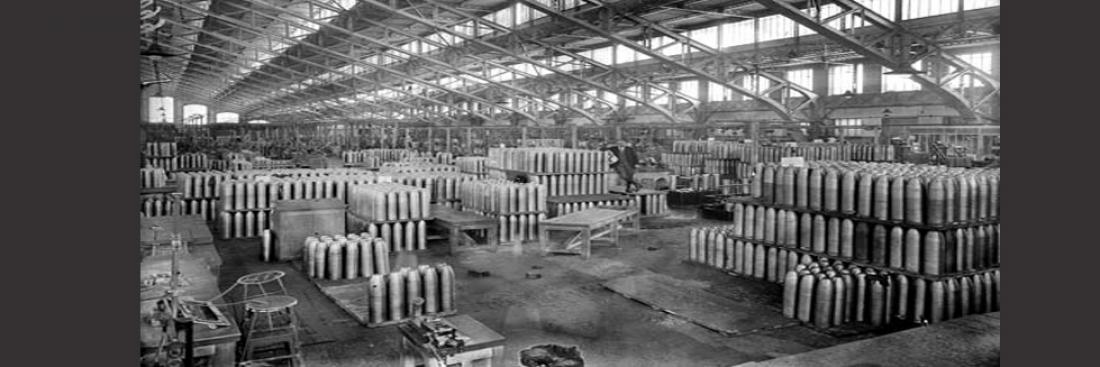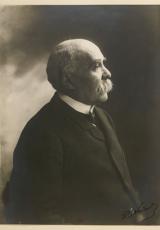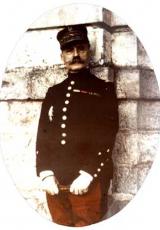Produire pour la Victoire

Corps 1
MANUFACTURING FOR VICTORY INDUSTRIAL MOBILISATION
Corps 2
Following the battle of the Marne, it became necessary to support the mobilisation of men by mobilising the manufacturing industry. In September 1914, the national defence industry was producing 10,000 75 mm shells every day, whilst a battery of 4 weapons could use 1,000 for every day of combat. High Command demanded delivery of 100,000 shells a day, a figure that was achieved from the spring of 1915 onwards. Two fundamental actions were responsible for launching the war industry's forward planning programme: the call to private companies (Citroën, Schneider, Saint-Chamond), with an advance of capital to create vital plants in order to get manufacturing underway and, most importantly, an increase in the volume of production. As a result, 500,000 workers were to leave the front for the workshops and gunpowder factories up until the end of 1915.
By the beginning of 1918, this industrial workforce of specially assigned workers reached a total of about 518,000 men, not including another 300,000 on detachment working in agriculture (figures from the summer of 1917), with a total manpower of 5.2 million in the armed forces. It was not enough, but the army was very quick to oppose large scale departures away from the front line, either because it feared weakening the actual fighting workforce, or because these specialist men were needed for its own services: railways, maintenance, artillery and engineering workshops etc. Other reserves of manpower were therefore needed, most importantly, women. It was not always without reluctance on the part of those concerned. In the Bar-le-Duc area, refugees who had come from the north of the region refused to go into factories to improve their lot. Afraid of the close contact in the workshop environment, its toxic emissions that "could lead to sickness", they preferred to continue to get by on their allowance of 1.50 Francs a day. But in the end, this recruitment was widespread enough to create a new feminine mindset in the country.
In the armaments industry in 1918, there were 425,000 civilian workers, 430,000 women, 330,000 youths under the age of 18, 13,000 disabled ex-servicemen, 108,000 foreigners, 61,000 colonials, 40,000 prisoners of war and 497,000 servicemen assigned to the industry. Despite the serious question of raw materials (the great coalfields and ironworks in the north and the east were occupied), the industry turned towards a new way of operating. Up until the end of the war, France was the largest Allied manufacturer of arms, due to imports of coke, coal and iron.
Quoted by Gerd Hardach, The other front, 1914-1918 Notebooks of "Social movement", No.2, 1977, p. 87
For aviation, an equally keen performance was accomplished - almost double the production of 1917. Quoted by J.M. Laux, The other front (...), p. 182
THE STRIKES In the first half of 1918, French morale remained uncertain and in the industrial areas social unrest took hold again. (29 départements had more than 10,000 workers employed in the war factories; the Loire département had 108,000, the Rhône 76,000 etc.). The fate of the war was as much in the hands of the workers as it was in those of the "poilu" (a slang term for a French soldier). Albert Thomas, socialist under-secretary of state for Artillery and Munitions, had reminded Creusot of the fact in 1916: "Victory hangs there, in the smoke that fills this valley. We are counting on you, comrades, to seize it." In 1917, workers' unrest had worried the authorities. Departments dealing with "morale" therefore drew up a list of large industrial centres where trouble was feared to be more likely, due to the increase in the original population by a new, "uprooted" population. Some of these centres witnessed fresh outbreaks of disputes in the spring of 1918. On the 14th May in Grenoble, the 28 factories working for the war effort stopped production. On the 21st in Vienna a general strike was declared and all textile and metallurgical engineering factories joined the movement, taking a "revolutionary and pacifist" stand. On the 21st May in the Gard, a strike affected 2,076 workers out of 2,430 (of which 1,362 were conscripts) at the forges of Tamaris and spread to the forges of Bessèges. In the coalmining and metallurgical engineering areas of the Loire, the 1st of May was a day of unrest: 30,000 strikers in Saint-Étienne and action on an equally grand scale in Firminy and in Chambon-Feugerolle.
The violent general strike broke out on the 18th May and rapidly spread. On 21st May the core of the Loire's industrial centres was affected. More than 10,000 people decided not to start work again until armistice negotiations were started. Despite some clashes with the police and the cavalry (at stations, some women tried to prevent the departure of recalled soldiers from the classes of 1911, 1912 and 1913), the movement started to run out of steam from the 25th and on the 28th, order was restored. The capital had also witnessed its own surge of workers' unrest on 13th May.
On the 14th, the movement, starting with Renault in particular (100% on strike), affected the whole of the Paris region, where, in the 57 factories working for defence, 105,130 out of the 127,700 workers were on strike. But at the same time as the strike was spreading to the edges of the movement, it was yielding at its point of origin. From the 16th May, 50% of the strikers at Renault went back to work. By the 21st the action was over. In fact, the German offensives made the strikes unpopular. And a good number of workers believed that now was not the time to harm the war effort. "Whether it is in Paris, Isère or Gard, these strike movements of the spring of 1918 all have similar characteristics. There is no doubt that they reflect the sizeable pacifism of the working masses, but their sequence of events equally shows the uncertainty of the pacifists who want peace, but don't know how to get it. From which we almost immediately reach an impasse followed shortly afterwards by the stifling of the strikes, which will have achieved nothing. The workers must face facts: in a country at war, you cannot be, if you want to go beyond words, pacifists without being revolutionaries and without suffering extreme consequences, in other words, the possibility of the defeat of your country if your adversary is not resolved to peace. Now, it does appear that on the whole, the French workers were not defeatists.." J-J Becker, The French in the Great War, Lafont, 1980, p. 249.
Some strikers from Saint-Étienne were recalled to the army and assigned to the 149th Infantry Regiment at Épinal. Their morale appeared to be good and they seemed especially keen to prove themselves. "As regards thoughts for now and for the future, I have just one: to do my duty as a Frenchman, because I am one and I have never sold out; as for the future, any comrades from the workshops who have complaints to make can stand up for what they believe in on their own, as I shall now, in doing my duty as a French man." From CH... 149th I.R. Épinal, Saint-Étienne, 9th June 1918. Epinal Postal censor, 9th June 1918. S.H.A.T. 16N1460. J-B Duroselle, having examined the reasons for this sudden surge of strikes and their equally sudden extinction, concluded for his part: "It does also appear that in 1918 many of the workers, perhaps the majority, agreed with the way in which Clemenceau, Foch and Pétain were conducting the war." J B. Duroselle, History of the Great War, Richelieu Publications, 1972, p. 288.
National opinion had suffered from the most serious tensions since the start of hostilities. But the huge majority of workers, just like the whole nation, continued to believe that it was not in their interests to lose this war. And so the great strike movements of the spring of 1918 came to an end with the German offensive of May 1918, which was the most serious and the one that appeared closest to succeeding. It is clear that the strikers, although they certainly were "pacifists", were not "defeatists".



